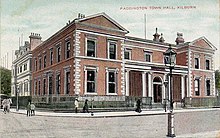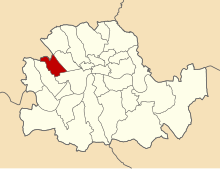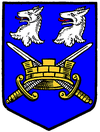Metropolitan Borough of Paddington
Paddington was a civil parish and metropolitan borough in London, England. It was an ancient parish in the county of Middlesex, governed by an administrative vestry. The parish was included in the area of responsibility of the Metropolitan Board of Works in 1855 and became part of the County of London in 1889. The parish of Paddington became a metropolitan borough in 1900, following the London Government Act 1899, with the parish vestry replaced by a borough council. In 1965 the borough was abolished and its former area became part of the City of Westminster in Greater London.
| Paddington | |
|---|---|
 | |
 Paddington within the County of London | |
| Area | |
| • 1911 | 1,356 acres (5.49 km2) |
| • 1931 | 1,357 acres (5.49 km2) |
| • 1961 | 1,355 acres (5.48 km2) |
| Population | |
| • 1911 | 142,551 |
| • 1931 | 144,923 |
| • 1961 | 116,923 |
| Density | |
| • 1911 | 105 inhabitants per acre (260/ha) |
| • 1931 | 107 inhabitants per acre (260/ha) |
| • 1961 | 86 inhabitants per acre (210/ha) |
| History | |
| • Origin | Ancient parish |
| • Abolished | 1965 |
| • Succeeded by | City of Westminster |
| Status | Civil parish (until 1900) Metropolitan borough (1900–1965) |
| Government | Paddington Vestry (until 1900, reformed 1855) Paddington Borough Council (1900–1965) |
| • HQ | Paddington Town Hall, Harrow Road |
 Coat of arms of Paddington Borough Council | |
 Map of boundary Map of boundary | |
History
editIts area covered that part of the current City of Westminster west of Edgware Road and Maida Vale, and north of Bayswater Road. Places in the borough included Paddington, Westbourne Green, Bayswater, Maida Hill, Queens Park, Kensal Green, West Kilburn, Maida Vale. To the south it bordered the Metropolitan Borough of Westminster, to the east, the Metropolitan Borough of St Marylebone.
The borough was abolished on 1 April 1965 by the London Government Act 1963 and its former area merged with that of the Metropolitan Borough of Westminster and the Metropolitan Borough of St Marylebone to form the present-day City of Westminster.
Borough council
editCoat of arms
editThe borough council's coat of arms, granted by the College of Arms on 5 April 1902, was based on the former Paddington vestry seal. The seal featured crossed swords from the arms of the See of London passing through a mural crown, symbol of local government. To these were added the wolves' heads and blue background from the arms of the first Mayor of the Borough, Sir John Aird.[1][2] Sir John, who was member of parliament for Paddington North, also donated the mayoral badge and chain.[3]
The arms were blazoned as follows:
Azure, two Swords in Saltire proper pommels and hilts Or enfiled with a Mural Crown of the last. Two Wolves heads erased in Chief Argent.[2][3]
Town hall
editPaddington Town Hall, designed by James Lockyer in the Classical style, dated from 1853.[4] The building, originally the Vestry Hall, was situated on Paddington Green. It was enlarged in 1900 and 1920. Following its closure in 1965, it was demolished to make way for the Westway urban motorway.[5]
Population and area
editThe area of Paddington Metropolitan Borough was 1,357 acres (5.5 km2), once part of Kensal New Town was added after 1901. The population recorded in the Census was:
Paddington Vestry 1801–1899
| Year[6] | 1801 | 1811 | 1821 | 1831 | 1841 | 1851 | 1861 | 1871 | 1881 | 1891 |
|---|---|---|---|---|---|---|---|---|---|---|
| Population | 1,881 | 4,609 | 6,476 | 14,540 | 25,173 | 46,305 | 75,784 | 96,813 | 107,058 | 117,846 |
Metropolitan Borough 1900–1961
| Year[7] | 1901 | 1911 | 1921 | 1931 | 1941 | 1951 | 1961 |
|---|---|---|---|---|---|---|---|
| Population | 143,976 | 142,551 | 144,261 | 144,923 | [8] | 125,463 | 116,923 |
- Note that the population statistics up to 1891 exclude the area of Kensal Town transferred from Chelsea in 1900.
Politics
editBorough council
editUnder the Metropolis Management Act 1855 any parish that exceeded 2,000 ratepayers was to be divided into wards; as such the incorporated vestry of Paddington was divided into four wards (electing vestrymen): No. 1 (12), No. 2 (18), No. 3 (18) and No. 4 (24).[9][10]
In 1894 as its population had increased the incorporated vestry was re-divided into six wards (electing vestrymen): Harrow Road (12), Maida Vale (9), Church (12), Westbourne (12), Lancaster Gate (15) and Hyde Park (12).[11][12]
The metropolitan borough was divided into eight wards for elections: Church, Harrow Road, Hyde Park, Lancaster Gate East, Lancaster Gate West, Maida Vale, Queen's Park and Westbourne.[13][14]
Parliament constituency
editFor elections to Parliament, the borough was divided into two and a half constituencies:
In 1918 the borough's representation was reduced to two seats:
See also
editReferences
edit- ^ Scott-Giles, C Wilfrid (1953). Civic Heraldry of England and Wales, 2nd edition. London: J M Dent & Sons. p. 257.
- ^ a b Crossley, Richard (1928). London's Coats of Arms and the Stories They Tell. London: Robert Scott. pp. 162–164.
- ^ a b Beningfield, T J (1964). London 1900–1964. Armorial bearings and regalia of the London County Council, The Corporation of London and The Metropolitan Boroughs. London: Ed J Burrow & Co. Ltd. pp. 129–130.
- ^ Nikolaus Pevsner, The Buildings of England: London except the Cities of London and Westminster Harmondsworth 1952
- ^ "Commemorative Green Plaque for the site of the Paddington Town Hall, at the junction of Hermitage Street and Harrow Road, W2" (PDF). Westminster City Council. 21 June 2018. Retrieved 18 June 2021.
- ^ Statistical Abstract for London, 1901 (Vol. IV); Census tables for Metropolitan Borough of Paddington
- ^ Paddington MetB: Census Tables accessed 19 June 2007
- ^ The census was suspended for World War II''
- ^ The London Gazette Issue: 21802. 20 October 1855. pp. 3879–3881. Retrieved 8 April 2015.
- ^ "H.M.S.O. Boundary Commission Report 1885 Paddington Map". Vision of Britain. Retrieved 8 April 2015.
- ^ The London Gazette Issue: 26526. 26 June 1894. p. 3671. Retrieved 8 April 2015.
- ^ The London Gazette Issue: 26548. 4 September 1894. pp. 5150–5152. Retrieved 8 April 2015.
- ^ Post Office London County Suburbs Directory, 1919. 1919. Retrieved 18 February 2015.
- ^ Ordnance Survey 'County Series 3rd Edition' Map of London (1912-14) at 1:2500 scale. Accessed at https://www.old-maps.co.uk/
Further reading
edit- Robert Donald, ed. (1907). "London: Paddington". Municipal Year Book of the United Kingdom for 1907. London: Edward Lloyd.